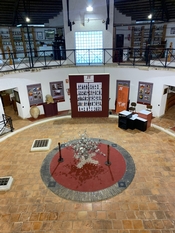 another trip earlier this year convinced me that Bobal from Utiel-Requena is Spain’s latest impressive gift to the world of wine.
another trip earlier this year convinced me that Bobal from Utiel-Requena is Spain’s latest impressive gift to the world of wine.
I can hear you from here: “What the heck is Bobal, and where the hell is Utiel-Requena?”
For starters, Bobal is a distinct variety with a recorded history stretching back to the 15th century. There’s a lot of it planted in Spain, though many of the vines are located in less-than-luxurious locations in regions like Castilla-La Mancha, and a fairly high proportion of the fruit from those vines goes into bulk wine production. Those two inglorious facts should be stated up front, but only as a segue to noting that well-situated, carefully tended, old vines of Bobal can make absolutely kick-ass wine.
This glorious fact is becoming ever more widely acknowledged within Spain, and it is an utterly safe bet that you’re going to hear a lot more buzz about this grape and see many more bottled renditions of it on store shelves and restaurant wine lists. Sheer quality is one reason for this, and reasonable pricing is another, but the variety’s viticultural characteristics also bode well for the future: Bobal retains its acidity while ripening better than most Spanish varieties, and also attains full ripeness at lower levels of potential alcohol, so forward-thinking vintners are placing bets on Bobal in a warming climate.
As for Utiel-Requena’s location, it is in the Autonomous Region known in Spain administratively as The Valencian Community, less than an hour’s drive 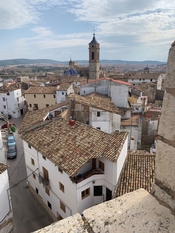 from the gorgeous port city of Valencia. The growing region is straight inland from Valencia and, importantly, upland too, reaching elevations of nearly 3,000 feet above sea level. There’s very ample sunlight for ripening, but also notable diurnal shifts in temperature. Precipitation is very sparse, but lots of clay content in the soils helps sustain the vines. The macro-climate is predominantly continental, but with a bit of maritime influence, though that’s mostly in the type of local vegetation…which is not irrelevant to the character of the wines (which often show subtle hints of lavender and garrigue, as in the wines along the Mediterranean coast of France).
from the gorgeous port city of Valencia. The growing region is straight inland from Valencia and, importantly, upland too, reaching elevations of nearly 3,000 feet above sea level. There’s very ample sunlight for ripening, but also notable diurnal shifts in temperature. Precipitation is very sparse, but lots of clay content in the soils helps sustain the vines. The macro-climate is predominantly continental, but with a bit of maritime influence, though that’s mostly in the type of local vegetation…which is not irrelevant to the character of the wines (which often show subtle hints of lavender and garrigue, as in the wines along the Mediterranean coast of France).
The towns within the appellation have suffered exactly the sort of de-population seen in almost all parts of Spain that are predominantly agricultural but fairly close to urban areas offering employment or seaside areas with touristic magnetism. This sounds a bit sad, but the same story has unfolded all across Europe during the past two generations, and there’s actually quite good news for wine in all of this. Historically, Bobal from this area was used to top off wines barrels that suffered evaporative loss while being transported from Rioja and Ribera del Duero for export from Valencia. The vine was very widely planted, but as both demand and labor declined, lots of growing sites were abandoned. Again, this sounds sad, but wait: The sites that are still producing are the ones with the best locations and the oldest vines.
A producer in the area told me that Utiel-Requena has the highest average vine age of any region in the world. That may be true, but the statistical training that was force-fed to me while earning a Ph.D. in a social science makes me 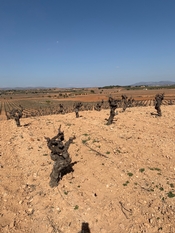 extremely doubtful that any such claim could be proved. However, having spent four days driving in the area, I hasten to add that the claim has plausibility. Vineyards dot the landscape here and there, but plots of young, wire-trained vines are conspicuous by their absence, whereas the great preponderance of plantings are of squat, gnarled old ogres trained en vaso, or as free-standing, head-pruned “bush vines.”
extremely doubtful that any such claim could be proved. However, having spent four days driving in the area, I hasten to add that the claim has plausibility. Vineyards dot the landscape here and there, but plots of young, wire-trained vines are conspicuous by their absence, whereas the great preponderance of plantings are of squat, gnarled old ogres trained en vaso, or as free-standing, head-pruned “bush vines.”
Although there’s no doubt that Bobal is the star in Utiel-Requena, this region is no one-trick pony. The whites can be surprisingly fresh, the rosé wines excellent (Bobal is very well suited to this purpose), sparklers can be very fine, and other varieties such as Garnacha and Cabernet Sauvignon can do quite well in the area. Which is good, because one cannot live by Bobal alone, though that possibility can be tempting once you’ve tasted a really good one from this region!
Nevertheless, the wines reviewed below are intended to show the range of excellence available from Utiel-Requena as well as some excellent examples of Bobal. I look forward to reviewing additional wines form the region in the months ahead, and any USA-based importer wishing to have wines reviewed should contact me at: [email protected]
Wines are listed in order of preference, reverting to alphabetical order when wines earn the same scores. Pricing is approximate, and availability will range from easy to spotty to challenging…but hey, that’s the story when you’re catching a region on the rise:
Dominio de la Vega (Utiel-Requena, Valencia, Spain) Finca La Beata Bobal 2014 ($38): Anyone who doubts that Bobal can make great wine should taste this, which will bring an abrupt end to the argument. A single-site 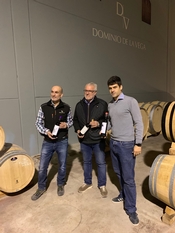 wine from a 1.5 acre plot that was panted between 1913 and 1920 (prior to the arrival of phylloxera), this was fermented in open-top wood fermenters prior to aging in new Allier barriques for 18 months. That new oak shows on both the nose and palate, but it is enveloped by gorgeous fruit benefits from the spiciness and grip lent by the wood without ever yielding center stage. The fruit shows a striking sappy sweetness but no hint of over-ripeness and the acidity is excellent, lending freshness and lift. The aforementioned sweetness has nothing to do with residual sugar, which is low at 2.5 grams per liter…just enough to help counterbalance the wood and tannin in the finish, which are simply swept away in sensory terms, though they still lend structure to the flavors and, presumably, age-worthiness to the wine. I tasted this at a lunch in a limestone cave with no internet connectivity, and the first thing I did upon emerging was attempt to order it…which is possible in multiple countries in Europe but not at any retailer I could find in the USA. The producer claimed it is being sold for $60 in Texas, so of course I’ll be planning a trip to … Texas. 95
wine from a 1.5 acre plot that was panted between 1913 and 1920 (prior to the arrival of phylloxera), this was fermented in open-top wood fermenters prior to aging in new Allier barriques for 18 months. That new oak shows on both the nose and palate, but it is enveloped by gorgeous fruit benefits from the spiciness and grip lent by the wood without ever yielding center stage. The fruit shows a striking sappy sweetness but no hint of over-ripeness and the acidity is excellent, lending freshness and lift. The aforementioned sweetness has nothing to do with residual sugar, which is low at 2.5 grams per liter…just enough to help counterbalance the wood and tannin in the finish, which are simply swept away in sensory terms, though they still lend structure to the flavors and, presumably, age-worthiness to the wine. I tasted this at a lunch in a limestone cave with no internet connectivity, and the first thing I did upon emerging was attempt to order it…which is possible in multiple countries in Europe but not at any retailer I could find in the USA. The producer claimed it is being sold for $60 in Texas, so of course I’ll be planning a trip to … Texas. 95
Chozas Carrascal (Utiel-Requena / Vinos de Pago, Valencia, Spain) “Las Ocho” 2016 ($38): Even a linguistic ignoramus like me knows enough Spanish to know that “Ocho” means eight, which raises the question, Which eight? The answer is, Bobal, Monastrell, Garnacha Tinta, Tempranillo, Cabernet Sauvignon, Cabernet Franc, Syrah and Merlot. My next question when tasting this at the (gorgeous) winery was, how much does it cost, and where can I buy it? My indication of a $38 price here is a world-wide average, as I haven’t yet found this sold at retail in the USA. Which has me kicking myself for not buying it at the winery, which I didn’t do solely to keep from checking a bag on my return flight. Stupid! This is a fabulously tasteful, skillful blend that is really only medium-bodied but very expressive in aroma and flavor, with a mélange of red and black fruit notes, interesting savory undertones, perfectly integrated acidity and wood, super-fine tannin and a wonderfully symmetrical finish. Generally, new-ish, ultra-fancy wineries tend to make overblown “statement” wines, but this is a terrific exception to the rule. Some savvy US importer will start bringing this bodega’s wines into the USA before long, and when they do, I’ll be able to stop kicking myself. 94
Sierra Norte (Utiel-Requena, Valencia, Spain) “Bercial Ladera Los Cantos” 2015 ($32): This is a big, serious wine crafted from 63% Bobal and 37% Cabernet Sauvignon made from old vines (60 and 40 years for the two varieties, respectively) and aged for more than a year in French Oak. That oak isn’t shy, but neither is it excessive, as the layered fruit is more than up to the task of counter-balancing it. Layered and long, this shows mostly black fruit tones with a topnote of oak spice and an undertone of cocoa powder. Medium-plus body will make this quite versatile at the table, and there’s no doubt it can benefit from a good five years of cellaring. 93
Pago de Tharsys (Utiel-Requena, Valencia, Spain) Organic Brut Reserva “Único” 2013 ($45): This house makes good still wines but also downright amazing bubbly from Bobal, and though a $45 price tag will make almost anybody wonder if they shouldn’t be buying Champagne instead, this will prove completely convincing as a superior purchase for anyone lucky enough to find a bottle. Treated to a lavish 40 months on the lees from the second fermentation, this is marvelously complex, with both autolytic and oxidative notes perfectly complementing the still-fresh fruit, which has a delightfully striking (but not obvious) similarity to apples or applesauce. I hesitate to even note that similarity, as premium sparkling wines should really be rather restrained, and any suggestion of overt fruitiness could send the aforementioned “anybody” over to the Champagne aisle in a retail shop. But trust me…this manages to be both restrained and expressive, which is no small feat. Buy this wine. 93
Bodegas Vibe (Utiel-Requena, Valencia, Spain) Bobal “Parsimonia” 2017 ($36): Terrific wine made from 65 year-old vines, with just exactly the right kiss of oak. This sees eight months in French barrels, with the yeast lees stirred for the first four of those, before settling for the following four. Red and blue fruit notes are absolutely delicious, with wonderfully expressive flavors but nothing too overt or obvious. Dark and concentrated but definitely not overbearing, this is a great ambassador for Bobal. 93
Chozas Carrascal (Utiel-Requena / Vinos de Pago, Valencia, Spain) “Las Tres” 2017 ($22): This blend of 40% Sauvignon Blanc, 30% Chardonnay and 30% Macabeo (a.k.a. Viura) was barrel fermented and then aged for six 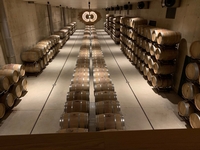 months in French oak, with no malolactic fermentation. But enough regarding technical matters: This is flat-out delicious and extremely well made, showing very restrained oak and superb integration. The citrusy notes of Sauvignon are most prominent in the bouquet, but the wine certainly doesn’t taste or seem generally like a varietal Sauvignon Blanc; rather, this is its own, unique thing, and a beautiful thing at that. The wine has a reputation for aging extremely well (I’m told that the 2013 is still being poured in a two-star Michelin restaurant and is very much alive), and I find that entirely easy to believe. Bloody terrific wine. 92
months in French oak, with no malolactic fermentation. But enough regarding technical matters: This is flat-out delicious and extremely well made, showing very restrained oak and superb integration. The citrusy notes of Sauvignon are most prominent in the bouquet, but the wine certainly doesn’t taste or seem generally like a varietal Sauvignon Blanc; rather, this is its own, unique thing, and a beautiful thing at that. The wine has a reputation for aging extremely well (I’m told that the 2013 is still being poured in a two-star Michelin restaurant and is very much alive), and I find that entirely easy to believe. Bloody terrific wine. 92
Sierra Norte (Utiel-Requena, Valencia, Spain) Bobal “Temperamento” 2015 ($18): Made entirely from Bobal fruit grown up at some of the highest elevations in the appellation, over 2,900 feet. The vines behind this average 60 years of age, yet the oaking is on the modest side at just six months, which enables the fruit to shine. I tasted this in mid-July of 2019 at my home, so it didn’t benefit from any “halo effect” of being tasted in the beautiful setting of Utiel-Requena. Moreover, I tasted it with dinner alongside a much more expensive Douro red, and this was obviously superior in purity, balance and overall sheer deliciousness. Medium-plus in body, with fine grained tannins and a nice little edge of spice, this is substantial but fresh at once, suited to an extremely wide range of foods. 92
Dominio de la Vega (Utiel-Requena, Valencia, Spain) Paraje Tornel Bobal 2012 ($24): The 2016 vintage of this wine is also worth a search, but is pretty tight on account of ample acidity and wood at this point, whereas this 2012 is just singing at the moment. It shows very expressive dark-toned fruit with alluring accents of lavender and garrigue, along with a nice little whiff of oak spice. Mature but not yet leathery or showing any signs of fatigue, this is terrific Bobal at a very attractive price. 92
Valsangiacomo (Utiel-Requena, Valencia, Spain) Clos de Sanjuan Bobal 2014 ($26): This wine is still showing brilliant, deep color at nearly five years of age, which gets it off to an impressive start. Things only get better from there, as a lovely whiff of oak spice lends complexity to the bouquet, just as a savory undertone on the mid-palate and finish shows the benefits of significant time in bottle. 15 months in 500-liter French oak casks was just perfect for this nicely concentrated, old vine fruit. Terrific juice. 92
Bodegas Vibe (Utiel-Requena, Valencia, Spain) Tardana “Parsimonia” 2018 ($16): When’s the last time you tasted a wine made from Tardana? I’d have been hard-pressed to answer that question myself when I enjoyed this wine in March of 2019, but one thing I can tell you for sure is this: I won’t miss my next chance to try a wine made from Tardana. An extremely late-ripening variety, this doesn’t get picked until the weather turns bad in autumn each year, and even then, this producer noted that 12.5 percent alcohol is the highest they’ve ever yielded. This 2018 rendition was labeled at 11.5 percent, and that seemed entirely plausible, as there’s a terrific sharp edge to this. Yet, this is no tart little wine along the lines of classic Muscadet, and in fact, my tasting note likens it instead to Semillon, which is nearly at the opposite end of the white grape variety spectrum. The aromas shows fascinating notes of garrigue, dried herbs and pine resin, and the flavors recall melons and figs…which is where the similarity to Semillon comes in, also on account of grippy texture. I’d have loved to taste an older bottle of this wine, as I can’t imagine that it doesn’t show positive development for at least two or three years, but sadly, in the absence of direct experience, that’s merely guesswork on my part. Hence my score, while high, is conservative. Buy this if you can find it…which is exactly what I will do. 92
Pago de Tharsys / Carlota Suria (Utiel-Requena, Valencia, Spain) Organic Chardonnay 2017 ($22): Granted, there’s no worldwide shortage of Chardonnay, but we can never get too many excellent examples at affordable prices. This only gets two months in French oak, but the barrels must nearly all be new, as this has very nice toasty, spicy topnotes. Medium-bodied, with good substance but also fresh acidity, this is admirably complex for less than $35, and at $22, it is a steal. 91
Sierra Norte (Utiel-Requena, Valencia, Spain) “Pasión de Bobal” Rosé 2018 ($13): This is excellent rosé demonstrating that Bobal can serve very well indeed as the base grape for this product category. The aromas and flavors show straightforward red cherry notes up front, with cranberry also suggested, though that’s perhaps a suggestion deriving as much from the wine’s outstanding acidity as much as the fruit tone. Picked at just the right point to achieve maximum freshness without any excessive tartness, this shows very good work in the vineyard and fine handling in the winery. 91
Valsangiacomo (Utiel-Requena, Valencia, Spain) Rosado “Bobal de Sanjuan” 2018 ($13): This is certainly among the very best rosé wines I’ve tasted during 2019, and the total is pushing 200, so that’s saying something. The core aroma and flavor notes recall red pie cherries, but of the best quality…not the low-rent taste of red Life-Savers. The fruit notes are brightened by admirably fresh acidity, and the wine finishes convincingly dry, which is a bit of a surprise after the initial blast of juicy fruit. Dangerously gulp-able…so beware! 91
Valsangiacomo (Utiel-Requena, Valencia, Spain) Bobal “de Sanjuan” 2017 ($20): This un-oaked rendition of Bobal shows just how good this variety can be … even without any winemaking enhancements. Open fruit flavors show both red and black tones, and the weight of the wine easily counterbalances tannins that lend grip but no harshness or astringency. There’s enough acidity to provide lift and freshness, but no tart edge…just delicious fruit flavor that seems completely pure and natural. 91
Pago de Tharsys / Carlota Suria (Utiel-Requena, Valencia, Spain) Organic Bobal 2017 ($22): This is a very strong introduction to Bobal, with a judiciously-applied dose of French oak over a period of eight months lending some complexity but not obscuring the pure, delicious fruit. Red fruit tones predominate over black ones, but both are present, and both are delicious. Moderately concentrated, with solid tannins but no notable astringency, this can stand up to grilled red meat, but will also prove very successful with lighter dishes such as roast chicken. 90
Bodegas Vibe (Utiel-Requena, Valencia, Spain) Bobal Crianza “Parsimonia” 2016 ($21): This wine shows more rusticity than most bottlings of Bobal, but that’s a side worth seeing. The texture is a bit more grainy and grippy than most of the wines I tasted in a concentrated period during March of 2019, and the flavors likewise display a slightly earthy undertone…but a pleasant one that seems coherent with the wine’s other sensory attributes. To be clear, there’s nothing “dirty” at all about this (no brett, for example), just a gutsy character that would make this a terrific partner for grilled lamb. 89
